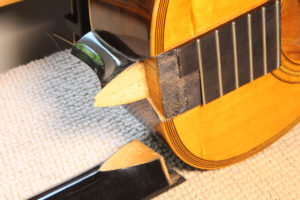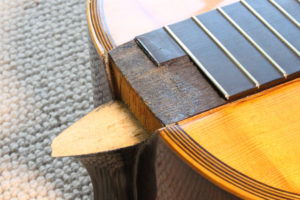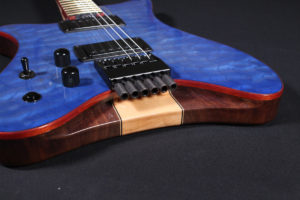Flame Guitars Newsletter-Late April
Flame Guitars Newsletter-Late April 2020
As I write this newsletter the early evening sun is casting beautiful shadows across my garden. The weather we have been experiencing recently has been wonderful (April showers it has not been) It is also remarkably quiet compared with the normal traffic noise I normally hear where I live.
And yet this quiet and this Spring sunshine seem to strangely clash with the reality of the times we are living through. I am well aware that many are experiencing worries about what the future may hold.
But I hope you are well and finding time and space to reflect, learn something new or do something you wouldn’t normally do. My wife and I have been on several sunrise walks recently. Something I don’t think I would ordinary do.


Repair of a broken neck on a 1865 parlour guitar
In this newsletter I thought I would cover the repair of this rather lovely parlour guitar (this is what we would call this size of guitar today)
This guitar has been in the family for 150 years and the owners were, not surprisingly, very upset when the neck broke. The guitar had been hanging on the wall when suddenly the neck broke off. I suspect that a glue line had dried out and, under the tension of the strings, the two glued parts of the heel had separated, snapping the ebony finger-board in the process. Although this may look like a disaster, on inspection of the guitar, I was confident that a good repair could be made.
This guitar also has an interesting history. As a small plaque on the fret-board shows, the guitar was given by “Geo to Lulu in 1865”. The owners of the guitar confirmed that “Lulu” was Lulu Sweet, a popular singer and entertainer who worked on the western side of America around that time. Indeed, there is an island near Vancouver, Lulu Island, that is named after her.

Essentially there are two stages to making this repair. Firstly, the neck needs to be glued back in place, and, secondly, the damage to the finish around the crack line needs to be repaired. As is often the case when a guitar neck breaks, the crack line on this guitar was very “clean”. (although a small piece of the heel had broken away and had to be replaced). So once glue had been applied and the two parts of the neck clamped together, a good, sound repair was achieved.
The next stage of this job was to repair the damage to the finish along the crack line. To do this I used my airbrush gun and applied nitro-cellulose lacquer. Having left the lacquer to dry and harden for a week I levelled and polished out the finish. I am pleased to say that on completion of the work the neck break was all but invisible.
I made a video which shows how the repair was made. You can find this video on my website or on my Youtube channel.
Content of the next newsletter
Last year I was asked to build a headless guitar for a customer. I really enjoyed this project. So I thought I would cover this in the next newsletter.
That newsletter will appear in your inbox in about two weeks. In the mean time stay safe and, where we can, look out for others who need our help.

